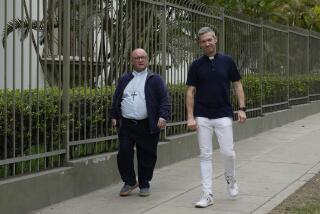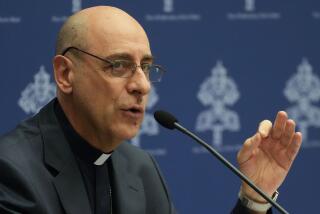PERSPECTIVE ON CATHOLICISM : Time Proves Religious Basis for Tolerance : A Vatican II dispute led by an American and a future Pope set the stage for a human-rights revolution.
- Share via
Thirty years ago today, the Catholic bishops of the world, by a vote of 1,954 to 249, approved the Declaration on Religious Freedom, the most disputed document of the Second Vatican Council. The bishops knew they had made a bold change in the church’s self-understanding. But few foresaw that the declaration would influence the lives of entire nations as various as Poland, the Philippines and Chile.
The declaration was controversial at Vatican II because adopting it involved discarding a long-held view of the preferred arrangement of church establishment, in which a confessional state gave Catholicism special privileges. On this understanding, religious freedom of the sort that prevailed in the United States was merely a tolerable, albeit useful, alternative until such time as demographics and politics made the legal establishment of Catholicism possible.
But the bishops of the council had to wrestle with several pressing historical realities. Established churches in Western Europe were dying. The church’s historic entanglement with coercive state power was impeding its evangelical mission. Totalitarians had made the subordination of the church an essential plank in their platform while creating a 20th-Century “church of martyrs.” And then there was the United States, a liberal democracy in which religion flourished under a constitutional separation of church and state.
Fresh from the experience of anti-Catholic bigotry during the 1960 presidential campaign, the American bishops went to Rome in 1962 eager to challenge what they regarded as the historical anomaly of the confessional-state position. East-Central European bishops, enmeshed in a life-and-death struggle with communism, wanted Vatican II to take a bold stance in defense of the church’s freedom from state interference. During the council, both parties found that the intellectual spadework necessary to sustain a development of doctrine in Catholic church-state theory had been done by Father John Courtney Murray, an American Jesuit. Murray’s research had persuaded him that the confessional-state position was, in fact, not all that traditional and that the whole thrust of modern Catholic social doctrine supported a constitutionally limited state with no sacred mantle.
A small group of bishops considered this heresy, a fatal concession to modernity. But the Americans, led by Murray, and the East-Central Europeans, led by the 45-year-old archbishop of Krakow, Karol Wojtyla (now Pope John Paul II), prevailed. And then, unexpectedly, came the politically explosive consequences of their victory.
It turns out that religious freedom is not an inert doctrine; it has dramatic public consequences. For if there is a sanctuary of conscience inside every human person where no earthly power can legitimately tread, then the state is, by definition, a limited state. In that sanctuary of conscience, we are wrestling with matters of ultimate importance. To say that the state has no business interfering in that conversation means that the fundamentally important matters in life are the business of other communities. And that implies social pluralism.
Thus religious freedom is not just anti-totalitarian and anti-authoritarian. The doctrine of religious freedom gives the church a certain populist cast. Indeed, it requires the church to stand with those who challenge the modern state’s pretensions to omnicompetence and omnipotence.
In the years after Vatican II, the Declaration of Religious Freedom, conceived as a piece of theological housekeeping, quickly began to inspire a Catholic human-rights revolution around the world. A church that had long been regarded as the last bastion of the old order now assertively defended the basic rights of the human person whether they were threatened by commissar, caudillo or bureaucrat. That made the church a major player in the third wave of democratization--as a rogues gallery including Ferdinand Marcos, Wojciech Jaruzelski and Augusto Pinochet could attest.
Andre Malraux said that the 21st Century would be religious or it would not be. State-sanctioned religion is often regarded as inherently coercive, divisive and violent; a glance at the headlines assures us that it can, in fact, be all of that. But 30 years ago, the bishops of Vatican II gave religious tolerance a religious foundation and put the Catholic Church, which now has 1 billion adherents around the world, on the side of persuasion and dialogue. That teaching helped topple dictators at the end of the 20th Century. It may help the world survive the 21st.
More to Read
Sign up for Essential California
The most important California stories and recommendations in your inbox every morning.
You may occasionally receive promotional content from the Los Angeles Times.













